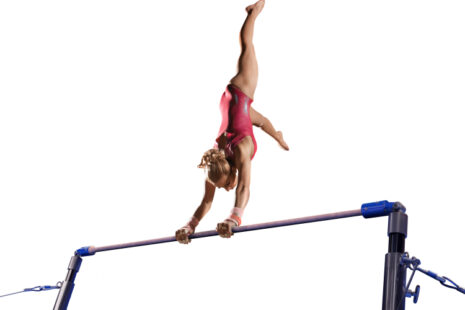In gymnastics, overuse injuries are common due to the repetitive nature of many movements and the high demands placed on the musculoskeletal system. Overuse injuries occur when tissues are subjected to repetitive stress without adequate rest and recovery.
Some common overuse injuries in gymnastics include…
- Stress Fractures – Stress fractures are small cracks or fissures in bones caused by repetitive impact or stress. In gymnastics, stress fractures commonly occur in the lower extremities, particularly the shins (shin splints), feet, ankles, and lower back (pars stress fractures).
- Growth Plate Injuries – Gymnasts who are still growing are particularly susceptible to growth plate injuries, which occur when the growth plates at the ends of bones are subjected to excessive stress. Common locations for growth plate injuries in gymnasts include the wrists, elbows, knees, and ankles.
- Tendinopathies – Tendinopathies, or overuse injuries of the tendons, can occur in gymnasts due to repetitive jumping, tumbling, and landing. Tendinopathies commonly affect the Achilles tendon, patellar tendon (jumper’s knee), and wrist tendons (gymnast’s wrist).
- Rotator Cuff Injuries – Gymnasts frequently use their upper extremities to support their body weight during skills such as handstands, cartwheels, and vaulting. Over time, this can lead to overuse injuries of the rotator cuff muscles and tendons, resulting in pain and dysfunction in the shoulder joint.
- Epiphyseal Injuries – Gymnasts who are still growing may experience injuries to the growth plates (epiphyses) of the bones, particularly in the wrists, elbows, knees, and ankles. These injuries can result from repetitive stress and may lead to growth disturbances if left untreated.
- Muscle Strains and Sprains – Repetitive movements and high-impact landings in gymnastics can predispose athletes to muscle strains (tears) and ligament sprains (stretch or tear) in various parts of the body, including the lower back, shoulders, knees, and ankles.
- Spondylolysis and Spondylolisthesis – Gymnasts may develop stress fractures in the pars interarticularis of the vertebrae, a condition known as spondylolysis. In severe cases, spondylolisthesis, where one vertebra slips forward over another, may occur. These injuries are often related to repetitive hyperextension of the spine during skills such as backbends and tumbling.
Preventing overuse injuries in gymnastics involves implementing proper training techniques, ensuring adequate rest and recovery, maintaining flexibility and strength, and gradually increasing training intensity and volume. It’s essential for gymnasts to listen to their bodies, communicate any pain or discomfort to coaches and healthcare providers, and seek prompt evaluation and treatment for any injuries to prevent them from worsening.



